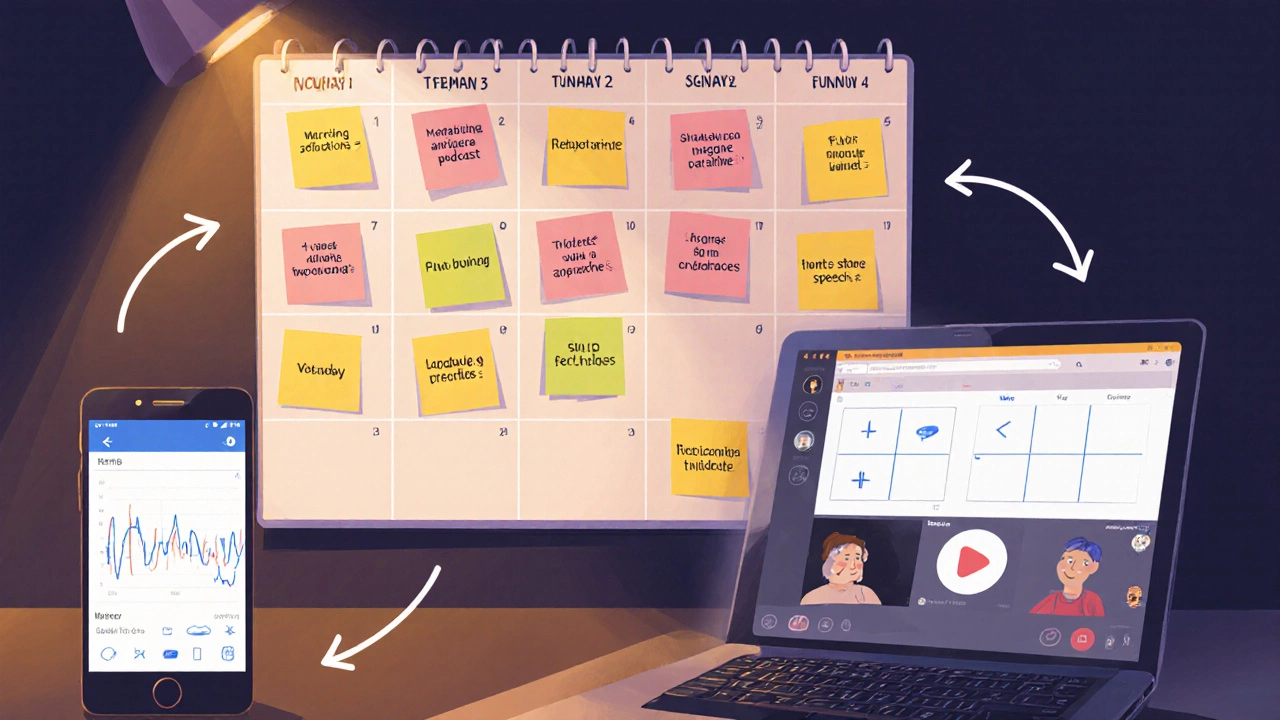English Speaking Confidence Tracker
Total Minutes Practiced
0 minutes
New Words Learned
0 words
Average Confidence Rating
0/10
Key Takeaways
- Adopt a growth mindset and treat mistakes as learning steps.
- Use short daily drills - listening, shadowing, and speaking to yourself.
- Pair up with a language partner or join a speaking club for real‑time feedback.
- Record, review, and adjust your pronunciation the way you form English sounds until it feels natural.
- Track progress with simple metrics - minutes spoken, new words used, confidence rating.
If you’ve ever felt your heart race before saying a sentence in English, you’re not alone. Below is a step‑by‑step roadmap that turns that nervous flutter into steady confidence.
What Holds You Back?
First, let’s name the enemy. confidence the belief in your ability to perform a task without fear in speaking English often collapses under two pressures: fear of being judged and the feeling that you don’t have enough vocabulary.
When you focus only on errors, you create a feedback loop that amplifies anxiety. The brain starts to predict failure, which in turn makes you stumble more. Breaking that loop begins with two simple observations:
- Everyone learns at a different pace - there’s no universal “right time” to be fluent.
- Mistakes are data, not defeat.
Adopt a Growth Mindset
Psychologist Carol Dweck calls it a growth mindset: believing abilities can improve with effort. Apply it to English by replacing thoughts like “I’m terrible at speaking” with “I’m getting better each day.” This mental shift rewires the brain to stay open to learning.
Practical tip: write three short affirmations each morning - for example, “I speak English clearly,” “I enjoy practicing,” “My accent improves with each chat.” Say them out loud; hearing yourself reinforces belief.
Build a Daily Speaking Habit
Consistency beats intensity. Even five minutes a day adds up. Here are three micro‑practices you can slot into a busy schedule:
- Shadowing: Play a 30‑second clip from a podcast or movie, then repeat it word‑for‑word, matching rhythm and intonation.
- Self‑talk: Describe what you’re doing while cooking, commuting, or cleaning - “I am chopping onions,” “The bus is arriving in two minutes.”
- Question‑answer flash: Write 10 everyday questions (e.g., “How was your day?”) and answer them aloud.
These drills increase fluency the smooth flow of speech without unnatural pauses and reduce the fear of a blank mind.

Expand Vocabulary Strategically
Learning random word lists feels useless. Instead, grow vocabulary around topics you love - cricket, Bollywood, tech, cooking. Pick five new words per week, then use each in at least three sentences you speak out loud.
Technique: the “word‑sentence‑conversation” chain. Pick a word, say a sentence, then weave that sentence into a mini‑dialogue with yourself or a partner. The context sticks, and you get practice forming thoughts around the new term.
Polish Your Pronunciation
Pronunciation isn’t about erasing your accent; it’s about being clear enough for listeners to understand you. Use the International Phonetic Alphabet (IPA) as a reference for tricky sounds like /θ/ (think) or /ɹ/ (red).
Two‑step routine:
- Record a short paragraph (30 seconds) on your phone.
- Play it back, note any sounds that feel off, and repeat the segment until it matches a native model.
Over time, you’ll notice a smoother flow and a dip in self‑monitoring anxiety.
Find a Language Partner or Speaking Club
Human interaction is the ultimate confidence booster. Look for a language partner someone you regularly practice speaking with, often via video calls on platforms like Tandem, HelloTalk, or local meet‑ups in Mumbai.
Guidelines for a successful partnership:
- Set clear goals - 15 minutes of casual chat, 10 minutes of feedback.
- Rotate speaking turns; each person gets equal airtime.
- Agree on a “no‑correction” phase where you just enjoy conversation, then a brief feedback window.
If in‑person clubs are scarce, join online groups such as “English Speakers of India” on Facebook or Discord channels dedicated to spoken English practice.
Leverage Technology for Real‑Time Feedback
Apps like ELSA Speak, Speechling, or even Google’s voice typing can pinpoint pronunciation gaps instantly. Use them after a daily practice session to fine‑tune specific sounds.
Another tech tip: switch the language on your phone or social media to English for at least an hour a day. The subconscious exposure builds comfort.

Manage Anxiety in Live Situations
Even seasoned speakers feel nerves before a presentation. Simple body‑language tricks calm the mind:
- Power pose: stand tall, shoulders back for 30 seconds before speaking.
- Box breathing: inhale 4 counts, hold 4, exhale 4, hold 4 - repeat three times.
During conversation, focus on the listener’s interest, not your performance. Asking open‑ended questions shifts attention away from self‑evaluation.
Track Progress and Celebrate Wins
Quantify improvement to keep motivation high. Create a simple spreadsheet with columns:
- Date
- Minutes spoken
- New words used
- Confidence rating (1‑10)
Review weekly - you’ll see trends like “confidence rose after each language‑partner session.” Celebrate milestones, whether it’s finishing a TED Talk summary aloud or ordering food fluently at an English‑speaking restaurant.
Putting It All Together: A 4‑Week Action Plan
| Week | Focus | Daily Action (≈15min) | Outcome |
|---|---|---|---|
| 1 | Mindset & Vocabulary | Morning affirmations + 5 new words in context | Reduced self‑criticism, richer lexical pool |
| 2 | Pronunciation & Shadowing | Shadow 30‑sec audio + record one paragraph | Clearer articulation, audible improvement |
| 3 | Partner Practice | 30‑min video chat with language partner | Real‑time feedback, conversational flow |
| 4 | Public Speaking Sim | Deliver a 2‑min talk to yourself, record, review | Confidence in structured speaking, reduced anxiety |
Stick to the plan, tweak it to fit your schedule, and notice how each week feels a little easier than the last. Confidence isn’t a switch; it’s a muscle that grows with use.
Frequently Asked Questions
Why does anxiety make my English sound worse?
Anxiety triggers the brain’s “fight‑or‑flight” response, which tightens muscles and steals focus. When you’re tense, you’re less likely to hear yourself and more likely to rush or freeze, leading to unclear speech and more mistakes.
How much should I practice each day?
Consistency beats marathon sessions. Aim for 10‑20 minutes of focused speaking daily. Short bursts keep the brain engaged without overwhelming you.
Is it okay to speak with a strong Indian accent?
Yes. An accent becomes a problem only when it hinders comprehension. Focus on clarity - clear vowel sounds, appropriate stress - and you’ll be understood regardless of regional flavor.
What apps help with real‑time pronunciation correction?
ELSA Speak, Speechling, and Google’s Live Transcribe give instant feedback on individual sounds. Pair them with a recording habit for the best results.
How can I keep motivated when progress feels slow?
Track tangible metrics - minutes spoken, new words used, confidence rating. Celebrate small wins, like finishing a short story aloud or receiving a compliment from a partner. Seeing data move forward fuels motivation.

